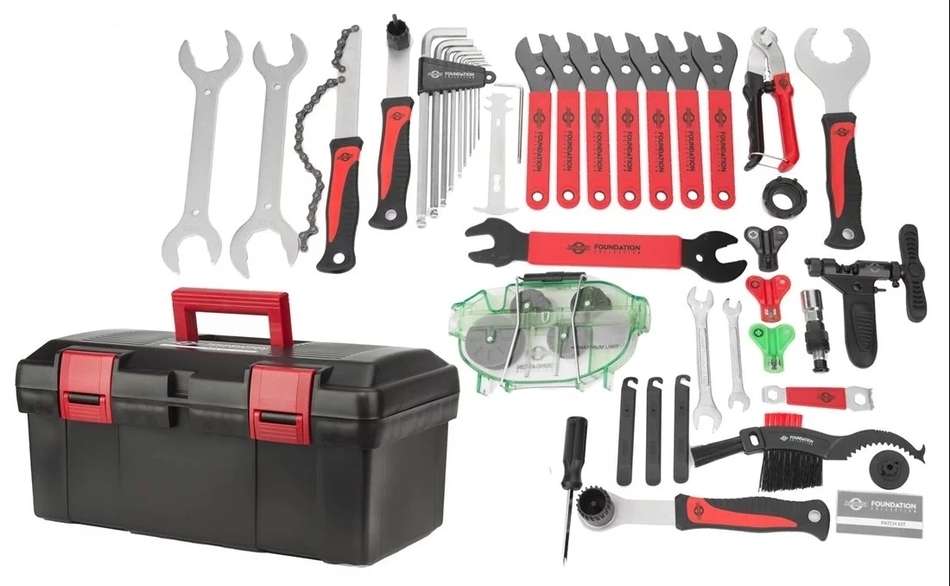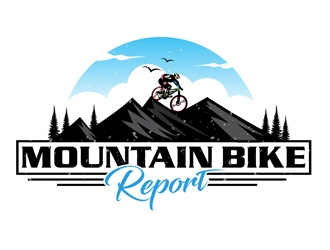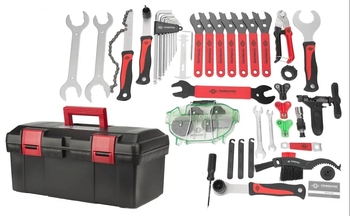
This guide will explain what you should put in your took kit for your mountain bike based on your level of mechanical experience
There will be tools for skill levels one, two, and three.
Level One Mountain Bike Tool Kit
In order to use these tools you do not need a workshop. The repairs and adjustments at this level are simple.
Tire Pump
Get one with a valve check and a gauge which will match your bike’s tubes which will either have Presta or Schrader valves. A lot of pumps will fit both. Because they wear out it is a good idea to have a spare rubber insert for the chuck.
Screwdrivers
You should have one of each size screwdriver. Small, medium, and large.
Phillips-head screwdrivers
You should have two sizes, a small one and a medium one.
Tire Levers
Have a set of 3 plastic ones.
Talcum Powder
Have one container for coating the inside of the tires. Be sure not to inhale any of it.
Patch Kit
Make sure you have one with sandpaper and not a metal scratcher. It should also have patches with a soft orange rubber backing.
Be certain the glue has not dried up. Do this by checking it every 18 months. It does not matter if the tube has been opened or not.
When you are on the trail take a little packet of glueless patches. They may not be so effective, but you will be glad you have them if the glue in your patch kit dries up.
Adjustable wrench
It should be at least six inches long.
Pliers
Have regular ones as well as needle-nose.
Metric hex-keys
Have one set of them. They should include 2.5mm, 3mm, 4mm, 5mm, 6mm, 8mm, and 10mm sizes. To keep your wrenches organized there are folding sets you can get. These are good for sizes less than 6mm.
For the bigger sizes, 6mm and up, you will need the full size model. You need more leverage for bigger bolts. You may also want to buy extras of 4, 5, 6, and 8mm hex key sizes.
Metric open-end/ box-end wrenches
This set should include 7, 8, 9, 10, 13, 14, 15, and 17mm sizes.
15mm Pedal wrench
This type of wrench is stronger and thicker than a cone wrench. Plus it is thinner and longer than a standard 15mm wrench.
Chain tool
This is for disconnecting and reconnecting chains. Make sure you get a good chain tool because they are easier to use. They line up the chain better so the pin goes in straighter and it therefore lasts longer. It will properly fit the latest narrower chains, plus it will have a replacement drive pin.
Many top of the line chain tools are compatible with older wider chains. For example Shimano, every time they change the number of cogs on the rear cassette they come out with a new chain tool.
The Shimano TL-CN34 11 speed shop tool works not only for the 11 speed but also on the 6, 7, 8, 9, and 10 speed chains as well. Plus it works on 12-speed SRAM chains.
Also Shimano’s TL-CN23 tool is good for Shimano 10 speed chains and also for 6 speed chains, 7, 8, and 9 speed chains.
The Pedro Pro 1.0 chain tool is for speeds 1 to 10. It has two extra locating teeth extending to either side. It helps to secure the chain better.
If you have an older mountain bike the Rohloff Revolver chain tool has been used for many decades and still works with more recent chains as well as 20 year old ones.
It uses a thumbscrew that tightens downward against the chain and fastens it, and a rotating plate with various patterns on it to peen the end of the rivet. The Rohloff also works on SRAM 12 speed chains.
Park’s CT-3 is used for prying a link apart to loosen a stiff link. It is an older, standard shop chain tool. It has both a front and back set of teeth.
Chain elongation gauge
This is used to check the condition of the chain.
Spoke wrench
Make certain that it matches the size of the nipples on your bike’s wheels.
Pad spacers
These are used when the wheel is out. Use this on disc brakes to stop pushing the pads out too far. In order to cut and hydraulic brake hoses, some pad spacers have an integrated bleed block and hose clamping groove.
Grease
This can come in a tube or in a jar container. It is best to use bicycle grease, but it is okay to use automotive grease. You can use automotive grease on all things except suspension forks, shocks, and twist shifters.
Chain lubricant
Try to choose one that is not an aerosol. They are easier to control, they need less packaging, and they waste less if there is an overspray.
Rubbing alcohol
This is used for removing and installing handlebar grips. You will also use it for cleaning disc brake pads, rotors, shocks, and internal parts.
Rags
Have lots of rags handy.
Shock pump
You need this if you have an air-sprung suspension fork or a rear shock. Find one with a no leak head. If your bike’s fork needs either a ball needle or a special adaptor to insert inside a sunken Schrader valve. Get the right adaptor for this.
Level 2 Tool Kit
When making level 2 repairs you’ll want to create a well organized work space along with a shop bench. Level 2 repairs are a little more difficult so it is good to keep your work space organized. This will help to make repairs and maintenance fast and simple.
You will need the complete level one tool kit along with the following must have tools.
Portable bike stand
When you are really pushing on the wrenches make certain the stand is sturdy enough to remain stable. For more stability you can choose a bike stand that holds the bike by the bottom bracket and the front or rear end with one wheel out.
Shop apron
Use this to protect your clothing from getting dirty or ripped.
Tire pressure gauge
This gauge is more precise than a pump gauge and is especially needed for the exact pressure for riding technically.
Hacksaw
Find one with a fine toothed blade.
Box cutter knife
Also called razor blades.
Files
Use files that are not too coarse. Get one that is round and another one which is flat.
Cable cutter
This is used for cutting brake and shifter cables without fraying them. They are also used for cutting coaxial shift cable housing without crushing it.
Metric socket wrenches
Have a set which consists of 7, 8, 9, 10, 13, 14, and 15mm sizes.
Torx keys
These keys look like hex keys with star shaped tips. Popular sizes are T10, T25, and T30.
Crank Puller
This allows you to remove crankarms. Depending on your crankset, the push rod is sized for either square taper spindles or ISIS or Octalink spindles. Get the right one for your type of spindle.
Chainring-nut tool
When tightening or loosening a chainring bolt you need to hold the nut in place.
Chainring cassette removal tools
Use this if you have old Shimano Octalink-style HollowTech 1 cranks.
Bottom Bracket Tools
Splined wrench
This is for external bearing cranks so you can remove the cups. You can also remove some center lock rotor lockrings.
Little splined tool
This is for tightening the left cranks adjustment cap for some Shimano cranks.
Splined step down inserts
Use this to fit smaller external-cup sizes without needing to buy a wrench or socket for each size. Plug it into a standard external bearing splined tool.
Splined bottom bracket socket
Use this for sealed cartridge bottom brackets.
Snapring pliers
Use for BB30 cranks and other unthreaded bottom brackets with snapring grooves and for use in removing snaprings from suspension forks, pedals, and other parts.
Cone wrenches
Check the size you need first. The most common sizes are 13, 14, 15, and 16mm.
Ball peen hammer
Use a medium size.
Headset wrenches
Check the size of the headset nuts first. You don’t need this if your bike has a threadless headset. Plus if you don’t plan on working on old bikes. Some suspension forks have crown nuts that fit headset wrenches.
Bench vise
Get a medium size and bolt it to the bench. This tool is especially useful for working on rear shocks.
Cassette lockring tool
Use it to remove cogs from rear hubs. Plus use it on Center Lock rotor lockrings.
Chainwhip
Use it to hold cogs in place while loosening the cassette lockring.
Pedro vise whip
This tool holds the cog more strongly and won’t fall off like a chain whip does when the freewheel rotates. This protects your knuckles when the lockring breaks free.
Drywall sanding screen
Use one which is (fine) and has (180 grit). Use them for sanding disc brake pads.
Valve core removers
They are used for tire service and shock service. Use them on Schrader and Presta valves.
Tire Sealant
Use this for installing into inner tubes for puncture protection, and for setting up tubeless tires.
Grease gun
Use one that has a fine tip.
Assembly paste
Used mostly on seatposts.
Silicone based grease
Find one in a tube container, if you have Grip Shift shifters.
Nonlithium suspension grease
Use on front and rear shocks and pivots.
Threadlock fluid
Helps to keep bolts tight which sometimes unscrew.
Penetrating oil or ammonia
Used to loosen stuck parts.
Cleaning tools
Tape, safety glasses, rubber dish gloves, or inexpensive latex gloves. Also, buckets, brushes, sponges, cog picks, degreaser, and dish soap or bike cleaner.
Level 3 Tool Kit
This more advanced tool kit is for mountain bike mechanics who can build a bike from the bare frame and up. You don’t have to be able to do this, it is just a guide so you have an idea as to the understanding of level 3.
Parts washing tank
Use a safe degreaser which is environmentally friendly. Be responsible about how you get rid of used solvent. You may want to check with your town environmental safety office.
Bench-mounted vise
Use one which is big. It is used to loosen stuck parts and press in others.
Shop chain tool
Use one which fits 6 speed to 11 speed or 12 speed chains.
Headset press
An inexpensive, uncomplicated press can press in any size headset and can install press-in bottom brackets.
Fork-crown race punch
This is also called a slide hammer and is used to install the fork-crown race of a headset. The steering tube at its base is what determines the size you will need. Check the steering tube size first.
Headset cup remover rocket
This is used when overhauling a threaded headset. It also can remove PF30 bottom brackets.
PF24 bottom bracket remover rocket
This tool is a smaller version of the headset cup remover rocket and is used for fitting through smaller bearings.
Star-nut installation tool
Use it for threadless headsets.
Ball peen hammer
Have a large one.
Soft hammer
To prevent damaging the parts you will be hitting use a mallet made of rubber, plastic, or wood.
Large sockets
Use this for working on the damper or air spring of a suspension fork. Most popular are 22, 24, 26, and 28mm, 6-point socket ground flat on the end.
Torque wrenches
Use this for tightening bolts. To prevent your parts from stripping, breaking, creaking, or falling off when riding, use the manufactured-specific torque settings. The larger the bolts the longer the torque wrench you will need. Same goes with smaller bolts.
Park IR-1 or IR-1.2 internal wire routing kit
This is used to help you get shift and brake cables, shift and brake cable housings, and hydraulic hoses through the frame faster and more easily.
Metric tapes
These are used for repairing mangled frame threads. Use ones which are 5mm by 0.8mm, 6mm by 1mm, and 10mm by 1mm.
Truing stand
Used for truing and building wheels.
Through-axle adapters for truing stand
When you are truing the wheel and the rotor this will securely hold a through-axle wheel.
Dishing tool
Use this to see that the wheel is correctly centered.
Spoke wrenches
Get them in all sizes.
Rotor truing gauge
This attaches to the truing stand and it checks the rotor alignment.
Rotor alignment forks
Use this when the disc brake rotors are not straight anymore.
Bleed kit
This is used for draining out the old fluid in the hydraulic brakes and then filling it up with new brake fluid. Use a bleed kit also for hydraulic release dropper posts.
Brake bleed block
When bleeding disc brakes this will keep the pistons pushed back.
Pin spanner
Use it to adjust Mavic hubs
Telescoping/ articulating magnet
Used for picking up parts and small tools.
Chain keeper
Used to clean drivetrain with wheel off. It attaches to the dropout to run chain over.
Vise whip or chain whip
Used to take apart old style 6 and 7 speed cogsets or freewheels.
Freewheel removers
For Suntour, Shimano, and Sachs freewheels.
Spare parts
Have on hand different sizes of ball bearings, zip-ties, spare cables, cable housing, and cable endcaps. Also have on hand, spare tires, tubes, chains, master links, and cogsets, hoses, seals, and fittings.
Carbon grip compound
Used for clamping carbon seat posts and handlebars.
Fluids
Have hydraulic brake fluids, hydraulic suspension oils and greases, threadlock fluid, titanium antiseize compound, outboard-motor gear oil.
Tools to carry when riding
Chain tool
Be sure that it works before bringing out on to the trails.
Small screwdriver
Use for derailleurs and other small parts.
Hex keys
Use on one which includes 2.5, 3, 4, 5, 6, and 8mm sizes.
Torx T25 wrench
This is for 6-bolt disc brake rotors and SRAM handlebar controls, and chainring spiders.
Multi-tools
In order to have less bulk and weight use this to substitute some or all of the preceding tools.
Tire pump/ co2 cartridge inflator
Use one which has a spare cartridge. Bigger pumps are quicker than smaller pumps. Be sure the pump or cartridge is compatible with your bikes valve.
Patch kit
After using the spare tube you’ll need patching. Check to make sure the patch kit glue has not dried every 18 months.
Tire levers
Have at least 3 plastic tire levers.
Shock pump
You need this only if your fork needs a pump adapter.
Spare tube
Store the tube in a plastic bag to stop it from deteriorating and to prevent it from getting damaged from sharp tools in your bag. Check the valves match the ones on your bike and pump.
Spare derailleur hanger
Used in case you crash on the drive side of your bike. Be sure it fits your frame.
Spare chain links/ 2 spare master links
Be sure it matches the chain width you are using from 8 to 12 speeds.
Identification
Have a drivers license or personal ID.
Taillight
Use one which you can mount on your bike.
Wet wipes and or latex gloves
To keep your hands clean
Keep the above tools in a bag under your seat. You can also use a hydration pack or a back pack. Try to use multi-tools as much as possible in order to reduce the weight and size. Check that they all work before bringing them with you out on the trail.
Essential Mountain Bike Tools to Carry on Long Rides
If you are going to be riding for long periods of time in addition to the tools just mentioned bring these along as well.
Spoke wrench
Get one that matches your bikes spoke nipples.
Spare spokes
Look for spokes made of Kevlar.
Sealant-filled fast aerosol inflator
To repair a tube or tubeless tire which has a slow leak.
Chain lube
Get a small plastic bottle.
Grease
Have a small tube.
Pedal wrench
It should be 15mm unless the pedals don’t have wrench flats. Having a pedal wrench which also has a headset wrench on the other end is good if you have a threaded headset.
Pliers
Can be used for many things.
Bungee cord or wire
Always handy for holding something together.
Duct tape
Very sticky and useful, you’ll know when you need it.
Cash and credit cards
Always handy in an emergency.
Matches
Maybe you get stuck outside overnight.
Emergency blanket
Get one that is lightweight, aluminized, and folds easily.
Rain gear
Depending on the weather forecast.
GPS
Let your loved ones know where you are.
Flashlight
Get a small one. This is just in case your bike or helmet light goes out.
Related
Top 15 mountain bike maintenance tips

